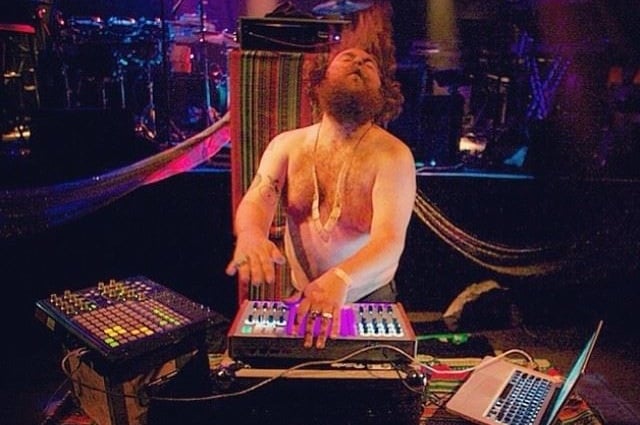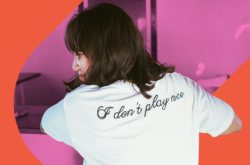The legendary hip hop producer speaks to Splice about his extensive catalog of hits.
What does Mannie Fresh sound like? Asked this question on his 50th birthday, the hip hop legend answers immediately. “Mannie Fresh represents energy,” he explains. “A good time, a fun time. If you’re having a bad day, put on Mannie Fresh.” Twenty one years after his first Billboard hit, that energy has become a key part of hip hop’s DNA. Getting his start as a teenage DJ in New Orleans, Mannie Fresh quickly began incorporating live drum machines into his sets, which in turn led to him producing his own tracks. That DJ mindset has stayed with him ever since, making up “99.9 percent” of how he approaches making a song to this day. His New Orleans bounce rhythms, unparalleled, bold horn and synth melodies, and next-level shit-talking have undoubtedly altered the sound of hip hop for the better.
In the late ’90s, Mannie Fresh famously joined Cash Money Records, guiding the sound of the label in its heyday and crafting the sound of iconic records for Juvenille, Lil Wayne, the Hot Boyz, and of course, himself. Tracks like “Ha,” “Bling Bling,” and “The Block Is Hot” set the stage for Cash Money’s takeover of the early 2000s, where Mannie Fresh continued to create massive hip hop hits like “Still Fly” and “Go DJ” while also crafting late-career bangers for legends like Toni Braxton and Teena Marie. Leading into the mid-2000s, Mannie had two of his biggest songs to date, both with T.I., with “Top Back,” and “Big Things Poppin’.” To summarize, over an eleven-year period from 1998 to 2009, Mannie Fresh produced 22 songs that made it to the Billboard singles chart and executive produced 22 albums which sold upwards of 20 million copies to date (13 of which went platinum), with 11 of them landing in the top ten of the Billboard 200. For one man, that is a track record for the ages.
The musical mastermind spoke with Splice about eight songs from his illustrious career, telling unheard stories about how these songs came together, which mistakes and unexpected rebuffs led to victories, and his long-lasting impact on the sound of popular music.
“Bitch Get Off Me” by Cheeky Blakk (1995)
The first song I want to ask you about is a “Bitch Get Off Me” by Cheeky Blakk, which has such an iconic instrumental. How did that song come together?
That song is the perfect marriage of a DJ and a producer. I was blending “Brown Beat” and “Triggerman” at clubs, just doing my little regular DJ set. Then I got a chance to merge both of them together and make a beat out of it, put the claps on top of it. That soul clap that always gets the party started. So Cheeky Blakk was the first one to get that. And like you said, that beat is so iconic to bounce music and twerk music because everybody has used it. Everybody has ripped that song one way or another. Even to this day, bounce music is made off of that loop. Sometimes you’ll do something in hip hop that belongs to hip hop, and I think that belongs to hip hop. I can’t say, “Everybody who used that owes me a percentage.” That is one of them rare times where something that you did as a DJ was something great, then it became a production, and now it belongs to everybody.
“Ha” by Juvenile (1998)
Let’s talk about “Ha.” It’s now twenty years later, and it still sounds futuristic.
The elements of that song are from everything. I took from Kraftwerk, from Mantronix, from old Moog synthesizers, old analog drum machines… That song came from an era of me listening to Euro records and stuff like that. I liked the synths and what they going at it. So I asked myself, “How do I figure out making something that cool, that our crowd would jam to?” Where they gonna get it, where it’s not going to go too far for them.
What are some of the other artists that you really like that people might not expect?
I like Rush. There’s a song on a Hot Boys album that’s close to a Rush song, and only people that are fans of Rush would know. If somebody says they don’t bite music, they’re lying. You’re going to get influences from everything. Tears for Fears, Depeche Mode, Lynyrd Skynyrd – that list could go on and on. There’s so much jamming music from different genres.
That whole album, 400 Degreez, is so masterful. Did you approach that record with a specific sound you were looking to bring to hip hop?
I wanted every song to sound different. Every song had a theme to it. You take “Back That Azz Up,” where we merged bounce with classical music. He’s got another song on it called “Ghetto Children” – that was Curtis Mayfield. So I took a lot of stuff from different places. I was like, “Let’s just get a cool-ass library of songs and find out what made these songs good. Why do they still stand the test of time?” That was the approach that I took for 400 Degreez.
“Still Fly” by Big Tymers (2002)
I would love to talk about “Still Fly” next. On first listen, it’s kind of straightforward and simple, but when you keep listening to it, there’s all these strange and intricate sounds that build that beat up.
“Still Fly” was one of those songs that was a lifeline for Cash Money, because Juvenile had left and people were like, “What they gonna do without Juvenile? What’s going to happen?” So when I was writing the song, as well as producing it, I just knew in my heart, don’t put no spin on it, and make sure it’s the truth. When I was doing the song, I remember everybody hated it. In old interviews, Baby and them admitted it as well. Everybody was like, “I don’t know what he’s doing in there. He’s saying shit about everything is in his momma’s name, that he got a quarter tank of gas, it goes against everything that’s supposed to be Cash Money.” And I’m like, ‘No, it’s really not. This is what people do in the name of ballin’.” It was for the regular man. It was for the regular girl. And that’s why I knew the song was going to come across so well – because this was everybody’s life, black, white, Asian, whatever you are! Something in that hook affects you, something in that hook you felt. So you can’t do nothing but put a smile on your face and dance to that song.
“Go DJ” by Lil Wayne (2004)
The next era I want to talk about is the sessions for Tha Carter, and specifically “Go DJ.” What kind of sound were you and Wayne going for with that record?
The crazy thing is that “Go DJ” is a beautiful disaster. I had done that song a while back. I did it for UNLV, and Wayne loved the song. So he was just like, “Man, remember this song that you did? Maybe three years ago, and it was called ‘Go DJ?’” He was like, “Can I use that?” And I was like, “Let me revamp it and we could do it.” Before he even wrote the lyrics to it, we had this idea that we was going to send out these camcorders to DJs that were all over the nation, and just let them film themselves and send it back. And that’s how we were going to make the video. I already had an idea of how we were going to make this song big. So fast forward – now we’re getting into the studio. Wayne lays down the first verse and the first verse don’t have shit to do with a DJ (laughs). So I’m like, “Dude, I’m not understanding. I thought we said we was going to make this song about DJs! We got a whole budget together to send people cameras!” And he was just like, “Yeah, but this beat so hard, I can’t rap about DJs.”
The reason why I call it a beautiful disaster is because the hook and the raps have nothing to do with each other. After I heard it when he was done, I was like, “Shit, it’s good enough to go.” He had grown lyrically. It’s just one of those songs that took off and nobody even paid attention to the hook and the rap being completely different from each other.
“Still In Love” by Teena Marie (2004)
That same year, you also produced a record for Teena Marie.
That’s the one. That is one of the high points in my career, because, real talk, I’ve always loved Teena Marie. Growing up in New Orleans, you grow up on Maze and you grow up on Teena Marie. I never thought in a million years I would get a chance to meet Teena Marie, let alone work with her. When I first met her, I fanned out. I called my dad like, “You ain’t gonna believe who I’m with right now.” I’m whispering like a kid who just met their favorite celebrity.
When we started talking about the song, she was like, “I want something like your sound – I want those drums.” And I was kind of scared to tell her, but I was like, “I don’t want to rub you the wrong way, but you’re Teena Marie. I cannot use drum machines and synth sounds. It’s gotta be real musicianship. We probably could get away with a drum machine, but everything else gotta be played.” And she was like, “What do you mean?” I’m like, “We’re going to play it the same way you grew up, the same way y’all did music. There’s gonna be a count off and the musicians are going to play the song all the way down.” And two more times she was like, “I think I need something that’s younger,” and I’m like, “No you don’t! You’re already iconic status, you don’t even get it.” I’m glad I stuck to it because that was her only gold record. All throughout her career, the songs that she’d done had done well, but none of them really crossed over like that.
That record really sounds timeless and just fits right in with her catalog. Yet, you can still tell that it’s Mannie Fresh.
It was important to me that it fit with her. There’s been times where other seasoned, older artists were like, “Oh, well he did it for Teena, he could do it for us,” and I turned down those songs. It’s gotta be iconic to what you did. That means the world to me. Rather than saying, “I’m going to do a song and I’m just going to sell out and put a drum machine behind you.”
You’re always going to be true to the artist. You’re never just giving someone a ‘Mannie-Fresh-type-beat.’
I would be filthy rich if I could learn to do that because there are so many songs where I have just been like, “Nah, I’m not doing that” (laughs).
“Big Things Poppin’” / “Top Back” by T.I. (2006 / 2007)
The next song I wanted to talk to you about is “Big Things Poppin’,” which is the highest-charting song that you’ve worked on so far. How did that record come about? What excited you about that song?
It wasn’t so much the record, it’s T.I. We’ve been friends forever, before he even had a deal. I was trying to get him signed to Cash Money. I was just like, “Listen, one day this kid is going to be a star.” And they just didn’t hear it. So I always stayed in touch with Tip. I did a song on his first album called “The Greatest.” Then fast forward a couple of years, he done blew up. So he comes back like, “Bro, you’re one of those dudes that believed in me,” and you know, and I’m telling him, “I’ve been a fan as well as somebody who believes in you.” So when we did “Top Back” and “Big Things Poppin’,” it was a big deal for me. I knew it had to be right for him. And the crazy thing is, “Top Back” was actually Juvie’s song. I was trying to resurrect what was going on with Juvie, and Juvie didn’t like the song! And I had Tip do the hook before Juvie walked into the studio. So I was like, “Listen bro, this is the song that’s going to bring you back,” but he was just like, “Man, hell no, it’s too loud. I don’t like it,” and walked out. T.I. couldn’t believe that. So Tip said, right then and there, “Can I have that song?” I was like, “Hell yeah, you can have it.” So in the beginning of the song, T.I. says the line like, “I’m going to show him what to do with one of your beats,” (laughs). He was just so hurt that Juvie just walked in and walked out. But he brung that song home. He killed it.
“1999” by Big K.R.I.T. (2017)
So I want to ask you about “1999” with Big K.R.I.T. How did that come about? Did they approach you first?
That song totally came together as us just clowning around. We was in BMI’s office in Atlanta and they got a small studio in there, and every time I go there I always record. So K.R.I.T. had came up there, Lloyd had came up there, and I was just playing the bassline. And the bassline is “You Can Have a Piece of My Love,” Teddy Riley’s song. Basically I was just messing around playing basslines. And [Big K.R.I.T.] was like “Let’s make a song out of that.” And I was just like, “Well before we do it, let’s call Teddy Riley.” So we call Teddy Riley, and he says, “Y’all can use it, I’m not trippin’.” Most people that work with me, they’ll tell you like I just clown around and come up with hooks. So I’m goin’, “It would be cool if the hook of the song was like ‘Back that ass up like it’s 1999.'” Immediately Lloyd started singing, you know, and I was just like, “Wow, put that down!” It was one of them songs that came together in literally like 10 minutes. We completed the song right there and went out that night.
That’s also just a testament to the timelessness of “Back That Azz Up.” How does it feel to be able to go into a session all of these years later and still pull new things out of that song?
Most sessions start out like this. “Give me something like back that ass up” (laughs). And I’m like, “I can’t do it. That song’s already made.” That’s how most sessions start – it don’t matter who it is. That one will always the come up.
Mannie Fresh brings his matchless energy to Splice with “Mannie Fresh’s Drum Lord Kit Volume 1.”
Get fresh, original, and exclusive releases daily from top artists, producers, and sound designers across genres:
March 26, 2019



